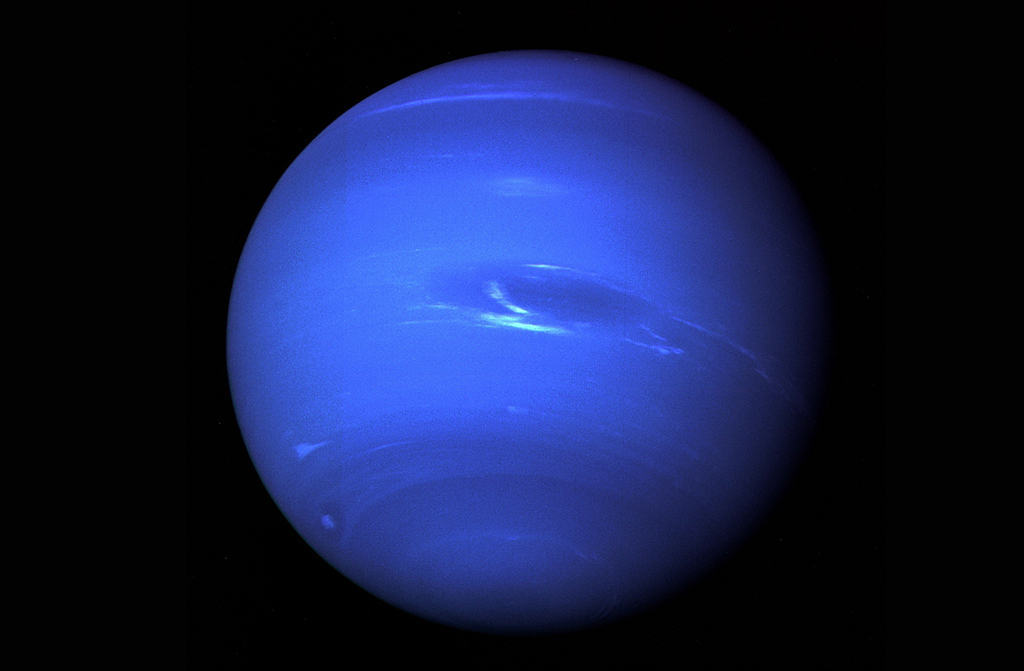
The clouds on Neptune suddenly disappeared because of the sun
Clouds on Neptune come and go, but why this happens has remained a mystery until now. Astronomers have now discovered that the eleven solar cycles have something to do with it.
About every eleven years, the polarity of the Sun’s magnetic fields reverses. This is accompanied by intense solar flares and an increase in the number of sunspots. When the activity peaks, the magnetic fields collapse and the poles flip. Then the sun comes to rest again to finally start a new cycle.
too far from the sun
The effect this has on Neptune’s clouds is remarkable, because the planet is so far from the sun. Only 0.1% of the sunlight that reaches Earth reaches Neptune. However, the planet’s clouds are affected by solar activity, not by the four seasons, each of which lasts about 40 Neptune years.
discovery It didn’t happen overnight: Hubble, NASA’s famous space telescope, has been observing Neptune for at least thirty years. In addition, data from the W.M. Keck Observatory in Hawaii and observations from the Lick Observatory in California were used.
Clouds gone
As a result, astronomers saw the clouds suddenly recede in 2019. “I was amazed at how quickly the clouds on Neptune were disappearing,” says Emke de Pater, professor emeritus at UC Berkeley. “We’ve seen cloud activity collapse within a few months.” And these clouds didn’t just come back. “So far, four years later, the latest images from last June show that the clouds have not yet reached their old level,” said researcher Irandi Chavez. “This is very exciting and unexpected, especially since the previous period when there were few clouds on Neptune was not as intense and lasted much shorter.”
wild again
Images from Hubble and others reveal an interesting cloud pattern dependent on the seasons and the solar cycle. When the weather is harsh on the sun, more ultraviolet radiation flows into the solar system. The researchers found that two years after the peak of the solar cycle, the number of clouds on Neptune is increasing. There was also a correlation between the number of clouds and the brightness of the ice giant due to sunlight reflecting off the planet.

“These impressive data provide the strongest evidence yet that cloud thickness on Neptune is related to the solar cycle,” says de Pater. “Our findings support the theory that ultraviolet radiation from the Sun, if strong enough, can start a photochemical reaction that causes clouds to form on the planet.”
delay
Since the solar cycle lasts eleven years, it took some time for scientists to show the connection to the clouds on Neptune. They tracked 2.5 cycles of cloud activity over a 29-year period. During this period, the planet brightened in 2002 and dimmed again in 2007. The planet brightened again in 2015 and darkened in 2020, when the cloud number diminished.
The brightness of Neptune, caused by the sun, appears to be waning and fading at the same rate as the planet’s clouds, albeit with some delay: the peak of the solar cycle comes two years earlier than the peak of the sun, the clouds on Neptune. That’s because a photochemical reaction takes place in the upper atmosphere of Neptune and it takes time for clouds to form.
There is still a lot to learn
“It’s great that we can use telescopes on Earth to study the climate of a world billions of kilometers away,” says astronomer Carlos Alvarez at the Keck Observatory. “Technological advances and better observational capabilities have allowed us to make better models of Neptune’s atmosphere. They have been crucial to understanding the relationship between the ice giant’s climate and the solar cycle.”

But astronomers still don’t understand everything. For example, increasing the sun’s ultraviolet radiation can produce more clouds, but also make them darker and thus reduce the brightness of Neptune. Storms on Neptune also affect cloud cover but are not associated with photogenic clouds. So correlation studies can be held with the solar cycle. Also, more observations of Neptune are needed to see how long the near absence of clouds lasts.
Neptune versus the outer planets
“We have already seen more clouds on the latest Keck images, which were taken around the same time that the James Webb telescope observed the planet. These clouds were observed mainly in northern latitudes and at high altitudes, just as would be expected after the observed increase in rays UV during the past two years, says de Pater.
The data collected from Hubble, James Webb, and observatories on Earth will provide a lot of new information about the planet’s dynamic existence in the future. In this way, not only do we get a better understanding of Neptune, but we may also get the more distant exoplanets, since there are many Neptune-like planets out there.

“Web maven. Infuriatingly humble beer geek. Bacon fanatic. Typical creator. Music expert.”
